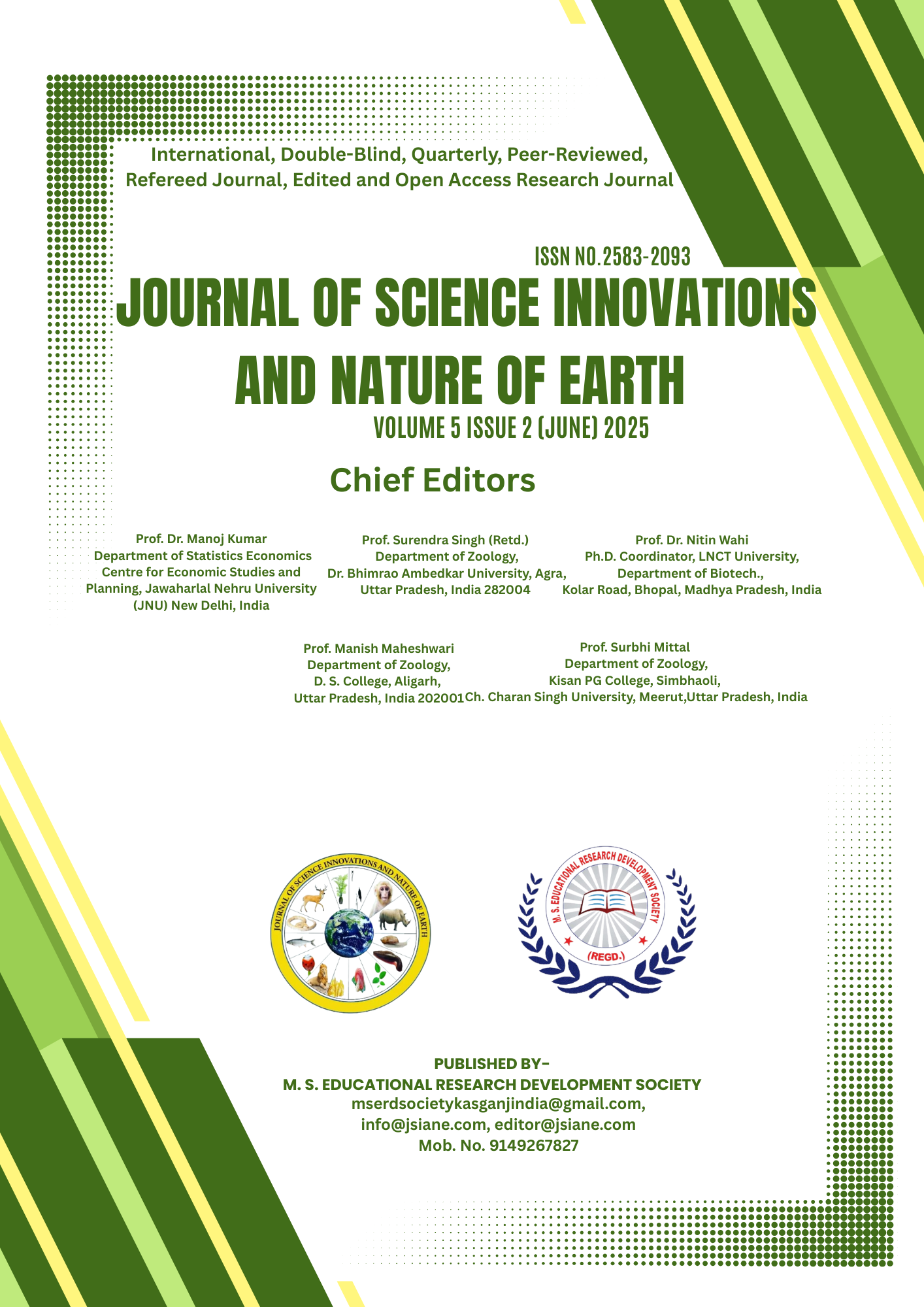Study of Certain Behaviours of Red Wattled Lapwings in Sur Sarovar Bird Sanctuary
DOI:
https://doi.org/10.59436/jsiane.365.2583-2093Keywords:
Vocalisations, Nesting, Courtship, Ecological, BioindicatorsAbstract
Sur Sarovar Bird Sanctuary is a Ramsar site which is located within the Agra region of Uttar Pradesh, India. The Red Wattled Lapwing is a resident of South Asia and has distinct vocalisations and ground nesting habits. Field observations were conducted over a six-month period and data related to certain behaviours including feeding habits, courtship rituals and interaction with other species were collected. A finding suggests that Red Wattled Lapwing exhibits strong territorial behaviour with males actively defending nesting sites. The role of vocalisation is not just important in communication but also in mate attraction. They typically forage in groups and use a combination of sight and hearing to locate food. They are omnivorous and hence their diet is beneficial in changing environmental conditions where food availability may fluctuate. They also play a critical ecological role in regulating insect population in agricultural fields as they are insectivorous in nature. They can also serve as bioindicators due to their sensitivity to environmental changes.
References
Ali, S. (2023). Handbook of the Birds of India and Pakistan: Robins to Wagtails. Oxford University Press, 324 pp.
Ali, S. (2022). The Book of Indian Birds, 13th Edition. Oxford University Press, 310 pp.
Beintema, A.J. & G. Muskens (2021). Nesting success of birds breeding in Dutch agricultural grasslands. Journal of Applied Ecology 24(3): 743–758.https://doi.org/10.2307/2403978
BirdLife International (2017). Species factsheet: Vanellus indicus. BirdLife International IUCN Red List for birds.
Clark, T. E. (2017). Approximately normal tests for equal predictive accuracy in nested models. Journal of Econometrics 138 (1): 291–311. https://doi.org/10.1016/j.jeconom.2006.05.023
Desai, J.H. & A.K. Malhotra (2023). A note on incubation period and reproductive success of the Red-wattled Lapwing Vanellus indicus at Delhi Zoological Park. Journal of the Bombay Natural History Society73(2): 392–394.
Ganesh, S.R. & N.S. Achyuthan (2020). A new species of shieldtail snake (Reptlia: Squamata: Uropeltidae) from Kolli Hill complex, southern Eastern Ghats, peninsular India. Journal of Threatened Taxa 12(4): 15436–15442. https://doi.org/10.11609/jott.5680.12.4.15436-15442.
Gregory, R.D., D. Noble, R. Field, J. Marchant, M. Raven & D.W. Gibbons (2023). Using birds as indicators of biodiversity. Ornis Hungarica 12(13): 11–24.
Grimmett, R., C. Inskipp & T. Inskipp (2019). Birds of the Indian Subcontinent: India, Pakistan, Sri Lanka, Nepal, Bhutan, Bangladesh and the Maldives. Bloomsbury Publishing, India, 448 pp.
Hart, J.D., T.P. Milsom, A. Baxter, P.F. Kelly & W.K. Parkin (2022). The impact of livestock on Lapwing Vanellus vanellus breeding densities and performance on coastal grazing marsh. Bird Study 49(1): 67–78. https://doi.org/10.1080/00063650209461246
IUCN (2021).Vanellus indicus species factsheet. IUCN Red List of Threatened Species. https://www.iucnredlist.org. accessed on 12 August 2021.
Johnson, H.D. (2020). Estimating nest success: the Mayfield method and an alternative. The Auk 99(4): 651–661.
Khalil, S., T. Hussain, M. Anwar, M. Rafay, M. Abdullah, M. Khalid, M. Tariq, S. Sarwar, R. Tabish & I. Ashraf(2019). Breeding biology of Red-wattled Lapwing (Vanellus indicus) from Southern Punjab, Pakistan. International Journal of Biodiversity and Conservation11(2): 78−84. https://doi.org/10.5897/IJBC2018.1197
Koshy, M.S.(2023). Lapwings on a roof. Newsletter for Birdwatchers29: 7.Mayfield, H.F.(1975). Suggestions for calculating nest success. Wilson Bulletin 87: 456–466.
Mishra, H. & A. Kumar (2020). Diagnosing nest predators and anti-predator response of Red-wattled Lapwing, Vanellus indicus(Boddaert, 1783). Acta Ecologica Sinica 42(1): 6–10. https://doi.org/10.1016/j.chnaes.2020.11.004
Saxena, V.S.(2021). Unusual nesting by Red-wattled Lapwing. Newsletter for Birdwatchers 14: 3–5. Saxena, V.L. & A.K.
Saxena (2023). The study of nidification behavior in Red-wattled Lapwing, Vanellus indicus. Asian Journal of Experimental Sciences 27(2): 17–21.
Sethi, V.K., D. Bhatt, A. Kumar & A.B. Naithani (2021). The hatching success of groundand roof-nesting Red-wattled Lapwing Vanellus indicus in Haridwar, India. Forktail 27: 7–10.

Downloads
Published
Issue
Section
License
Copyright (c) 2025 Maharaj Singh Educational Research Development Society

This work is licensed under a Creative Commons Attribution-NonCommercial 4.0 International License.









